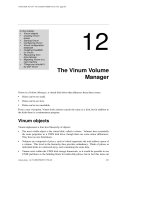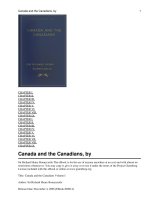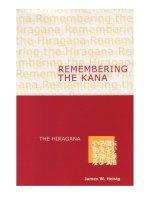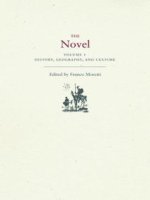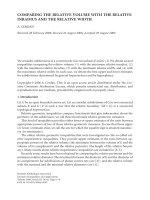Remembering the kanji, volume 3
Bạn đang xem bản rút gọn của tài liệu. Xem và tải ngay bản đầy đủ của tài liệu tại đây (5.74 MB, 437 trang )
Students who have learned to read and write the basic 2,000 characters run into the same difficulty that university students in
Japan face: the government-approved list of basic educational
kanji are not sufficient for advanced reading and writing. Although
each academic specialization requires supplementary kanji of its
own, a large number of these kanji overlap. With that in mind, the
same methods employed in Volumes 1 and 2 of Remembering the
Kanji have been applied to 1,000 additional characters determined
as useful for upper-level proficiency, and the results published as
the third volume in the series.
To identify the extra 1,000 characters, frequency lists were
researched and cross-checked against a number of standard Japanese kanji dictionaries. Separate parts of the book are devoted to
learning the writing and reading of these characters. The writing
requires only a handful of new “primitive elements.” A few are
introduced as compound primitives (“measure words”) or as
alternative forms for standard kanji. The majority of the kanji, 735
in all, are organized according to the elements introduced in
Volume 1. For the reading, about twenty-five percent of the new
kanji fall into “pure groups” that use a single “signal primitive” to
identify the main Chinese reading. Another thirty percent of the
new kanji belong to groups with one exception or to mixed groups
in which the signal primitives have two readings. The remaining
306 characters are organized first according to readings that can
be intuited from the meaning or dominant primitive element, and
then according to useful compound terms.
Six indexes include hand-drawn samples of the new characters
introduced and cumulative lists of the key words and primitive
meanings, and of the Chinese and Japanese pronunciations, that
appear in all 3 volumes of the series.
James W. Heisig is professor and permanent research fellow at the
Nanzan Institute for Religion and Culture in Nagoya, Japan.
Tanya Sienko spent ten years working for the Japanese government
and Japanese industry. After a period at the Warburg Institute
in London, she returned to the U.S. and now works as an
entrepreneur.
University of Hawai‘i Press
Honolulu, Hawai‘i 96822-1888
www.uhpress.hawaii.edu
Remembering the Kanji 3 · heisig & sienko
Japanese language
James W. Heisig • Tanya Sienko
Remembering the Kanji 3
Writing and Reading Japanese Characters for
Upper-Level Proficiency
remembering the kanji 3
by the same author
Remembering the Kana: A Guide to Reading and Writing the Japanese Syllabaries
in 3 Hours Each. Honolulu: University of Hawai‘i Press, 2007 (1987)
Remembering the Kanji 1: A Complete Course on How Not to Forget the Meaning
and Writing of Japanese Characters. Honolulu: University of Hawai‘i Press,
2007 (1977)
Remembering the Kanji 2: A Systematic Guide to Reading Japanese Characters.
Honolulu: University of Hawai‘i Press, 2008 (1987)
Kanji para recordar i: Curso mnemotécnico para el aprendizaje de la escritura y
el significado de los caracteres japoneses (with Marc Bernabé and Verònica
Calafell). Barcelona: Herder Editorial, 2005 (2001)
Kanji para recordar ii: Guía sistemática para la lectura de los caracteres japoneses (with Marc Bernabé and Verònica Calafell). Barcelona: Herder Editorial,
2004
Kana para recordar: Curso mnemotécnico para el aprendizaje de los silabarios
japoneses (with Marc Bernabé and Verònica Calafell). Barcelona: Herder Editorial, 2005 (2003)
Die Kanji lernen und behalten 1. Bedeutung und Schreibweise der japanischen
Schriftzeichen (with Robert Rauther). Frankfurt am Main: Vittorio Klostermann Verlag, 2006 (2005)
Die Kanji lernen und behalten 2. Systematische Anleitung zu den Lesungen der
japanischen Schriftzeichen (with Robert Rauther). Frankfurt am Main: Vittorio Klostermann Verlag, 2006
Die Kana lernen und behalten. Die japanische Silbenschrift lesen und schreiben
in je drei Stunden (with Klaus Gresbrand). Frankfurt am Main: Vittorio
Klostermann Verlag, 2006
Kanji: Imaginar para aprender (with Rafael Shoji). São Paulo: jbc Editora, 2007
Remembering the Kanji
vol. 3
Writing and Reading Japanese Characters
for Upper-Level Proficiency
James W. Heisig
&
Tanya Sienko
second edition
University of Hawai‘i Press
honolulu
Copyright © 1994, 2008 by James W. Heisig
All rights reserved, including the right to reproduce this book or portions
thereof in any form without the written permission of the publisher.
Printed in the United States of America
First edition: 2nd printing, 1995
Second edition: 1st printing, 2008
12 11 10 09 08 07
6 5 4 3 2 1
Library of Congress Cataloging-in-Publication Data
Heisig, James W., 1944Remembering the kanji : a complete course on how not to forget the meaning
and writing of Japanese characters / James W. Heisig. — 5th ed.
v. <1> ; cm.
Includes indexes.
ISBN 978-0-8248-3165-3 (pbk. : alk. paper)
1. Japanese language—Orthography and spelling. 2. Chinese characters—
Japan. 3. Japanese language—Textbooks for foreign speakers—English. I. Title.
PL547.H4 2007
495.6’82421—dc22
2006103109
The typesetting for this book was done at the Nanzan Institute for Religion and Culture.
University of Hawai‘i Press books are printed on acid-free paper and meet the guidelines
for permanence and durability of the Council on Library Resources.
Contents
Preface by Tanya Sienko
1
Introduction
3
part one: writing
1
2
3
4
5
6
New Primitives and Kanji Primitives
Major Primitive Elements
Miscellaneous Kanji
Western Measurements
Phonetic Characters
Old and Alternate Forms
13
24
120
134
136
138
part two: reading
7
8
9
10
11
12
13
14
Old Pure Groups
New Pure Groups
Semi-Pure Groups
Mixed Groups
A Potpourri of Readings
Kanji with Japanese Readings Only
Readings of Old and Alternate Forms
Supplementary Kanji
v
149
171
198
221
250
288
298
301
vi | contents
indexes
Index i
Index ii
Index iii
Index iv
Index v
Index vi
Hand-Drawn Characters
Primitive Elements
Kanji in Stroke Order
Chinese Readings
Japanese Readings
Key Words and Primitive Meanings
309
318
323
338
357
404
Preface
Tanya Sienko
When I first contacted Dr. Heisig with a proposal to add a third volume to
Remembering the Kanji, I somehow left the impression that it was my rather
esoteric needs as a scientist that left me hankering for more kanji than the
2,042 I had learned with his method. Actually, it was not the technical prose of
Yukawa and Tomonaga on field theory that were causing me my biggest headaches but ordinary Japanese novels. Having read mystery novels to polish my
reading in other languages, I was disappointed to fi nd that the “essential” or
“general-use” characters were simply not enough to gain entry into the Japanese thriller. After just a few chapters, my maiden voyage ended on the rocks.
So much for “basic literacy,” I thought to myself. And so was born the idea for
this book.
During the time of the American Occupation, the Japanese writing system underwent a complete overhaul, which saw the number of Chinese characters to be learned during the years of compulsory education reduced to a
bare minimum of 1,850. The idea was to simplify the system and facilitate literacy by removing rarely used kanji from circulation. What the reformers did
not count on in their long-range plan was the resistance of the general public to the disappearance of many kanji customarily used for names. Families
reacted by continuing to name their children with “traditional” names, but
the government refused to register the kanji. This resulted in the bizarre situation where a number of Japanese were growing up legally nameless. In 1951
the Ministry of Education grudgingly backed down and approved another 92
“legal” characters for names, followed by another 28 in 1976. In 1981 the number of “general-use” kanji was increased in 1,945 and in 1990 the kanji approved
for use in names was increased to 284. This is the situation at present.
Of course, there were still numerous kanji outside the list that continued to
be used in place names, or that appeared in books published before the educational reforms and were impractical to update. Over the past twenty years
many of these exiled characters have migrated back into daily use. Advertisers often prefer the compactness and precision of older kanji to their phonetic
1
2 | preface
equivalents. Increasing competition has induced universities to include more
and more “unofficial” kanji in their entrance examinations. And popular novelists, as always, cling tenaciously to their cache of little-known glyphs as a
mark of the trade. Finally, the ubiquitous word processor has turned the distinction between what is “allowed” and what is “disallowed” into something of
an anachronism.
For the foreign student who has landed in this mess, there have been only
two alternatives: either you adhere to the official list, or you stumble about
blindly trying to improve your knowledge as best you can. The idea behind
the present book was to offer a third choice: supplementary kanji to lay a solid
basis for contemporary Japanese.
In addition to the method of selection explained in Dr. Heisig’s introduction, I myself checked the final list against Edward Daub et al., Comprehending
Technical Japanese (University of Wisconsin Press, 1975), which used frequency lists to determine the 500 kanji most used in technical writings. With
the exception of characters specific to one field, this list is represented in the
pages that follow.
Of the many people who assisted me in this project, I would like particularly
to express my thanks to Ronald D. Mabbitt for help in the cross-referencing
and for his many useful suggestions on the structure of the book; and Kanda
Yumiko 神田由美子 for checking some of the more obscure compounds.
Introduction
The american philosopher William James once wrote that a great idea goes
through three stages on its way to acceptance. First, it is dismissed as nonsense. Then it is acknowledged as true, but insignificant. Finally, it is seen to be
important, but not really anything new. Time and again history confirms the
wisdom of James’s observation, but it also reminds us that the very same bias
that resists the invasion of novelty also serves to swat away many a flea-brained
idea buzzing about for attention.
In this connection, I must admit I am of two minds about Remembering the
Kanji and its companion volumes. I have always had the sense that there was
something flea-brained about the whole project. Its reception by students of
the Japanese language across the world has been as much a surprise to me as to
the original publishers. We had expected no more than a short buzz, followed
by a firm whack into oblivion. From the start I was convinced that if there was
anything important in the method, it surely was nothing new. All I had done,
after all, was to put some semblance of order into what students of the kanji
had always done: trick their minds into making easily forgettable shapes more
memorable. The sales of the books, as well as scores of letters from readers, has
convinced me that this is, in fact, the case.
On the one hand, the method seems to have proved itself a natural one
suited to large numbers of students motivated to study the kanji on their own.
On the other, it remains virtually useless for classroom instruction. Th is is
hardly surprising, since it aims to do something the classroom cannot do,
namely to tap the imagination of the individual at the individual’s own learning pace. To the native speaker of Japanese trained in the traditional school
system and trying to teach the Japanese writing system to those whose primary education was outside of the “kanji curtain,” it can only appear a distracting gimmick. For one who does not know from experience the question
behind the method, the answer—even if it works—makes no sense. Whatever
the merits of Remembering the Kanji as a learning tool, then, its demerits as a
teaching tool are beyond redemption. This is probably for the best. To force the
expectations of the textbook on the method would probably only end up frustrating everyone—teachers and students. The saving grace of the books is that
they are simply too flea-brained to run the circuit of “course work.”
Letters from readers have combined expressions of gratitude with more
3
4 | introduction
good ideas for improvements than I could ever assimilate into subsequent editions. The misprints that had slipped in along the way, thanks again to alert
readers, have been periodically corrected in later printings. For the rest I have
let the books stand as they are, reckoning that their unpolished edges encourage the very kind of participation that makes them work in the first place.
The one most common request that has haunted me over the years has been
for a supplementary volume that would pick up some of the more useful kanji
outside the lists propagated as standard by Japan’s Ministry of Education. The
request always seemed reasonable enough. When I myself had worked through
the official list of kanji, I was left with much the same feeling: learning to write
the characters is so simple—now if there were some list that could guide me
into learning more of them…. The only solution I could see was to learn new
characters as they showed up in reading. Unfortunately, I kept no records, and
could only reply to readers that they, too, let their particular reading habits
guide their acquisition of new kanji. But I always knew it was not quite the
right answer to an important question.
Then, about a year and a half ago, Tanya Sienko, a theoretical physicist
from the United States employed at Japan’s National Institute of Science and
Technology Policy, persuaded me that something concrete could be done. Her
idea was for a volume that would aim at raising proficiency to the level of 3,000
kanji, based on the methods of vols. 1 and 2 of Remembering the Kanji. The
present book is the result of our combined efforts.
The initial decision to aim at a list of 3,000 characters was not based on any
established measure of “upper-level proficiency,” but simply out of the need for
some parameters within which to begin working. As the selecting of new characters progressed, the decision justified itself and was left to stand.
The choice of which kanji to include and which to leave out was far from
simple. In 1990 the Ministry of Education published a revised list of characters
for use in names, 284 in all. Kanji from this list that had not been covered in
vols. 1 and 2 were added first, together with all their readings.
The next step was to consult a list of 3,505 characters published in 1963 by
the National Japanese Language Research Institute. Since 1956 the Institute had
been issuing periodic reports of research on the frequency with which kanji
appeared in various fields of study. Based on some 90 academic and popular
journals, a team of scholars turned up 3,328 characters, to which the Institute
added another 177. Although the list was not based on the Ministry of Education’s list of general-use kanji (常用漢字), it includes all the kanji found in the
latter (latest revision, 1977) but, as you might suspect, does not include all the
1「現代雑誌九十種の用語用字」
『国立国語研究所報告』22
(1963).
introduction
| 5
characters from the Ministry’s 1990 revised list for use in names. In any case, all
new kanji in the list with a frequency of more than 9 were selected. The following chart shows the breakdown of the frequency and the overlay of kanji used
for names. The darkened areas represent the first two groups of kanji checked
for inclusion in the present volume:
The next problem was how to sift through the remaining kanji to reach a
total of 3,000. The solution consisted in overlaying a completely new system of
classification that has taken the world of Chinese characters by storm since the
time of the frequency studies.
1978 marks a watershed in the story of the kanji and in the compilation of
frequency lists. It was in that year that the Japanese writing system was converted into computer code, opening the way to the use of the personal computer in Japan. There was never any question that Japan would march enthusiastically to the drum of the computer revolution. But to do so, some way had
fi rst to be found around the obvious impossibility of squeezing the Japanese
writing system into the 7-bit character codes that make up the American Standard Code for Information Interchange (ascii) character sets. In response to
the challenge, the Japan Industrial Standard or jis was born.
From the outset the jis classification has never wanted for critics, but the
complaints were largely muffled by the sheer thrill of having a simple tool to
manipulate the Chinese characters. In the early stages an initial list of less than
3,000 kanji (jis-1) was installed as standard in personal computers and printers, while a second list of over 4,000 kanji (jis-2) was sold separately. Writers
and specialists grumbled about characters left out of jis-1 and relegated to the
“second-class” status of jis-2. By the end of the 1980s, both character sets had
been adjusted and are now installed as standard in computer equipment.
The kanji that had been left out of both lists were another matter. Nearly
all word-processing programs have included utilities for creating 外字 or
“excluded characters.” Eventually a third set, the jis-supplement, was devised.
To date, it covers an additional 5,801 kanji. Th is supplement is not yet standard in personal computers and printers, though newer dictionaries include
the code numbers that have been assigned. In the near future it is reasonable
to expect that they, too, will become standard equipment.
2 jis-1 includes basic Roman, Greek, and Cyrillic characters, as well as a handful of general-use typesetting symbols.
3 Meantime, the early 1990s saw the arrival of Unicode, a workable worldwide standard,
based on 16-bit code, that would cover all writing and symbol systems. By that time the Japanese jis had already become a permanent fi xture, and adjustments were made to assign it a
place in the Unicode structure that would not confl ict with Korean and Chinese.
4 For an example of the most up-to-date kanji dictionary, which was relied on heavily for
the production of this book, see: 鎌田正・米山寅太郎著『大漢語林』(Tokyo: Taishūkan, 1992).
6 | introduction
The control of language, which has been an important cultural weapon in
the arsenal of modern governments for the past four centuries and more, has
brought political complications to the computerization of the kanji in Japan,
often masquerading in the robes of scholarly objectivity. Indeed, the more
voracious the popular appetite for computer access to kanji becomes, the more
these issues come to the fore. The Ministry of Education, for example, which
seems to have felt slighted by the designers of the new computer standards,
still makes no mention of the jis’s existence in its official lists of general-use
characters. Meantime, efforts by the Ministry to regulate the number of kanji
in general use have been undercut by the very computers it uses to compose
and print its regulations. There is no reason to think that the situation will
change in the years to come.
Most important for our purposes here, the wealth of characters seems to
have retarded research into standards of “upper-level proficiency.” After its latest revision in 1990, the tripartite jis list now contains a whopping 12,156 characters but does nothing to address the problem of frequency of use.
A simple, if time-consuming, procedure was followed in making the
selection of the remaining characters for this volume. First, all kanji that
appeared less than 9 times in the National Japanese Language Research Institute list and which also appeared in jis-1 were included. The selection was
then rounded off with a few characters that fell outside these borders but
which, from personal judgment, we thought it best to include. Graphically, the
final results look like this:
1,995 字
names
1,510 字
284 字
100+ x
653
31–100 x 636
9–30 x
707
1–8 x
1,133
supplement 177
}
3,505字
5 For a fuller account of these confl icts, see special issues of『しにか』dealing with 漢字と
コンピュータ [Kanji and the computer], 1/2 (1990), and いま漢字の規格化を問う [Rethinking the
standardization of the kanji at present], 4/2 (1993).
introduction
| 7
Chapter 14 reflects the authors’ dissatisfaction with the unavoidable arbitrariness in the selection process. It opens with a list of 7 kanji (3001–3007)
deliberately excluded from the selection process: 5 of them from the list of
names and 2 from jis-2 that seem worth learning. Space is left for you to record
additional characters that you wish to add to the list of “upper-level proficiency” kanji. In future editions, we hope to be able to add to this list of 7, but
that will depend on significant numbers of readers sending in their lists for us
to compare.
There are six indexes at the end of the volume. Index i shows hand-drawn
examples of all the new kanji introduced in this book. Index ii is a cumulative
listing of all the primitive elements and signal elements introduced in vols. 1,
2, and 3. Index iii arranges all the kanji from all 3 volumes in order of strokes.
Indexes iv and v contain cumulative lists of all the Chinese (on) and Japanese
(kun) readings for all the kanji treated in all 3 volumes. Finally, Index vi is a
comprehensive list of all the key words and primitive meanings appearing in
vols. 1 and 3.
Parts One and Two follow, respectively, the methods of vols. 1 and 2 of
Remembering the Kanji. The layout of the frames has changed slightly to
include cross-referencing. Frames in Part One look like this:
西
2796
要 r-2523
neck and throat 覃
覆
頚
覈
覇
spool . . . head. [14]
The key word here is meant to specify the anatomical neck, to dis覊
tinguish it from the broader uses of the character 首 (1.70).
見
西 Frame number. The enumeration is continued from vol. 1.
要 Frame number of reading. The corresponding frame appears in Part Two
of the present volume, the enumeration continuing from vol. 2.
覃 Key word.
覆 Kanji.
覇 Primitive elements.
覈 Number of strokes.
覊 Explanatory note. Italics are used to refer to primitive element, bold type
to the key word.
見 Cross-reference to vol. and frame.
8 | introduction
The frames of Part Two are patterned on the following sample:
西
辟
要
ヘキ
覃
壁
癖
r-851
r-852
覈
覊
僻
2624
R-
覓
僻見
僻む
視
覆
覇
ヒ
避
r-853
見
規
ヘキ
2117
ヘキケン
ひがむ
prejudice
be biased against
覗
覘
西 Signal primitive for the following frames.
要 Primary on-yomi of the signal primitive.
覃 Kanji from vol. 2 with the signal primitive and its primary on-yomi.
覆 Secondary on-yomi of the signal primitive.
覇 Kanji from vol. 2 with the signal primitive and its secondary on-yomi.
覈 Cross-reference to frame number in vol. 2.
覊 Kanji.
見 On-yomi of the frame kanji.
規 Cross-reference to frame in Part One.
覓 Frame number for Part Two (reading). These numbers are continued
from vol. 1.
視 Sample compound and writing for kun-yomi.
覗 Readings of sample compound and kun-yomi.
覘 English translation of sample compound and Japanese meaning.
The choice of sample words for on-yomi readings has been made with an
eye to providing useful vocabulary wherever possible, but here, too, there was
some arbitrariness. In the course of assigning readings to the kanji, a shelf of
dictionaries based on the jis lists was consulted and compared, only to fi nd
inconsistencies at every turn. Given the ease with which computerized data
can be accessed, one would expect at least an overall accuracy in indexing
and cross-referencing. This was not the case. To compensate for this, Index 6
errs on the side of excess, including more readings than are mentioned in the
frames of Part Two. The only exception was made for names: only those readings in the Ministry of Education’s updated list are contained in the index.
introduction
| 9
Otherwise, all four indexes cover all the kanji and readings contained in the
three volumes of the Remembering the Kanji series.
In conclusion, I should like to express my thanks to Torisawa Kazuko for
her meticulous checking of the completed typescript, and to Pat Crosby of the
University of Hawai‘i Press for taking over the publication of this and other
volumes in the series.
James W. Heisig
Nagoya
part one
Writing
Chapter 1
New Primitives and Kanji Primitives
new primitives
We begin our journey to 3,000 kanji with the addition of a few new primitive
elements to those already included in vol. 1. They have been included only if
they appear frequently enough in the kanji in general to be useful, or if at least
three instances appear in this volume. Each new element is followed by the new
characters in which it appears.
After this, all the primitives in this volume will already be familiar to you. If
you get stuck, consult the comprehensive list in Index ii at the end of this volume.
2043
this here
r-2670
此
footprint . . . spoon. [6]
2044
brushwood
r-2671
柴
this here . . . tree. [10]
2045
fort
r-2672
砦
this here . . . stone. [11]
2046
whit
r-2673
this here . . . two. [8]
些
14 | remembering the kanji 3
2047
beard
r-3140
髭
hair . . . shape . . . this here. [16]
sheik
髀
top hat . . . villain . . . belt . . . elbow. [10]
This element is already familiar from the character 離 (1.1492). The
reason the element for elbow requires 3 strokes instead of the usual 2
is that the combination of elements 髏 is actually a radical classically
defined as having 5 strokes.
2048
crystal
r-2454
璃
jewel . . . sheik. [15]
This is one of the seven classical stones of China.
2049
fowl
r-2843
禽
umbrella . . . sheik. [12]
2050
apple
r-2844
檎
tree . . . fowl. [16]
shoeshine
髑
rice . . . sunglasses. [12]
This combination of elements has already been learned from the character 隣 (1.1311). The assignation of the primitive meaning is almost
entirely arbitrary.
2051
sympathize with
r-2499
state of mind . . . shoeshine. [15]
憐
new kanji and kanji primitives
2052
phosphorus
r-2496
| 15
燐
fire . . . shoeshine. [16]
2053
camelopard
r-2498
麟
deer . . . shoeshine. [23]
The camelopard is a motley-colored mythical creature from China
with the body of a deer, the tail of a cow, and the crest and claws of a
bird.
2054
scaled
r-2497
鱗
fish . . . shoeshine. [23]
The scales referred to are those found on fish, dragons, and so forth.
2055
encompassing
r-2583
奄
St. Bernard . . . eel. [8]
The sense of the key word is of something that is expansive and covers
over everything. When used as a primitive, it will mean a dachshund.
Think here of a particularly large and l-o-n-g one to combine the qualities of the eel and the St. Bernard.
2056
hermitage
r-2582
庵
cave . . . dachshund. [11]
2057
shrouded
r-2584
掩
fingers . . . dachshund. [11]
The sense of the key word does not refer to an actually funeral “shroud,”
but only to the sense of being covered over or concealed.
2058
myself
r-2585
person . . . dachshund. [10]
俺
16 | remembering the kanji 3
The key word refers to a very familiar way of referring to oneself, usually restricted to men.
streetwalker
體
We learned this combination earlier in the character 俊 (1.1014) with
the elements person . . . license . . . walking legs. The primitive meaning
covers the sense of one “walking around licentiously.” [7]
2059
make amends
r-2501
悛
state of mind . . . streetwalker. [10]
2060
steed
r-2503
駿
team of horses . . . streetwalker. [17]
2061
steep
r-2500
峻
mountain . . . streetwalker. [10]
2062
complete a job
r-2502
竣
vase . . . streetwalker. [12]
2063
mortar
r-2973
臼
back-to-back staples. [6]
The mortar referred to here is a stone or wooden basin used for grinding with a pestle. As a primitive element it keeps the same meaning.
2064
father-in-law
r-3085
舅
mortar . . . male. [13]
2065
mouse
r-2964
mortar . . . two plows . . . four drops . . . hook. [13]
鼠
new kanji and kanji primitives
2066
bore
r-3039
| 17
鑿
standing in a row upside down . . . mortar and walking stick . . .
missile . . . metal. [28]
The sense of the key word is boring a hole into something.
break
2067
r-3043
毀
mortar . . . soil . . . missile. [13]
small craft
2068
r-2383
艘
boat . . . mortar . . . walking stick . . . crotch. [15]
I Ching
髙
The appearance of this element looks enough like one of the combinations used in the Chinese Book of Changes, the I Ching, to give us
a meaning for this element. Note that there is always something that
comes between the two halves to keep them apart. [4]
2069
rhinoceros
r-3018
犀
flag . . . I Ching . . . walking stick . . . cow. [12]
2070
lunar month
r-3007
皐
white dove . . . I Ching . . . needle. [11]
2071
spinal column
r-2915
脊
I Ching . . . umbrella . . . flesh. [10]
stitching
髞
This element is actually a character in its own right, a pictograph of
something that has been stitched. [8]
18 | remembering the kanji 3
2072
rice-field footpath
r-3141
畷
field . . . stitching. [13]
The character learned for paddy-ridge in vol. 1 畔 (1.1204) and that for
paddy-field ridge 畦, which we will meet in frame 2571, both mean the
“ridges” that run between rice paddies. The character introduced here
refers directly to the ridge that is used as a walking path.
2073
mend
r-2918
綴
thread . . . stitching. [14]
2074
let it be
r-2473
爾
spike . . . eight . . . belt . . . stitching. [14]
Note that the writing of the element for spike is interrupted by the
element for eight. This character—among whose older usages was as
a polite form of addressing someone—is now used chiefly in names,
except for the famous Buddhist expression that will be introduced
when its reading comes up in Part Two.
2075
imperial seal
r-2474
璽
let it be . . . jewel. [19]
hill of beans
豈
This element (actually a rather rare character in its own right) is made
up of exactly what it says: a hill of beans. [10]
2076
suit of armor
r-2486
鎧
metal . . . hill of beans. [18]
2077
triumph
r-2485
hill of beans . . . wind. [12]
凱

